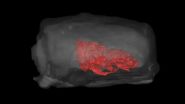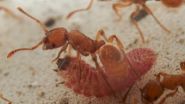(Press-News.org) VIDEO:
This is a spinning animation of fossil of male pupa and its position within the nest cell.
Click here for more information.
LOS ANGELES — The La Brea Tar Pits, the world's richest and most important Ice Age fossil locality, is most celebrated for it collection of saber-toothed cats and mammoths. The site's lesser known, but equally vast insect collection, is also of great significance. Recent examination of fossil leafcutter bee nest cells containing pupae, led by Anna R. Holden of the Natural History Museum of Los Angeles County (NHM) and colleagues, exemplifies how fossil insects reveal new insights into the local habitat and prevailing climate at the La Brea Tar Pits toward the end of the last Ice Age. The paper, entitled "Leafcutter Bee Nest and Pupae from the Rancho La Brea Tar Pits of Southern California: Implications for Understanding the Paleoenvironment of the Late Pleistocene," will be published in the journal PLoS One on April 9, 2014.
Holden conducted the study with bee specialists Jon B. Koch and Dr. Terry Griswold from Utah State University, paleobotanist Dr. Diane M. Erwin, from the University of California Berkeley, and Justin Hall from NHM, who used micro CT scans to reconstruct images of the nest cells and bees.
It was necessary to micro CT scan the specimens in order for Holden and colleagues to determine that each leaf-constructed nest contained an intact pupae. The team examined the physical features of the bees, the nest cell architecture, and used environmental niche modeling to best match the ancient Ice Age specimens to Megachile gentilis.
Because M. gentilis still lives today (as is the case with most insects excavated from the tar pits), the team linked records of its restricted climatic range to late Ice Age environmental conditions at Rancho La Brea which suggest that M. gentilis lived in a moderately moist (mesic) environment that occurred at a lower elevation during the Late Pleistocene. The identification of nest cell leaf fragments, which were collected in close proximity to the nest site, indicate a nearby wooded or habitat with a stream or river.
These unusual bee fossils, housed at the Page Museum at the La Brea Tar Pits, were recovered from Pit 91. Dating back to the beginning of the 20th century, scientists have unearthed more than 5 million fossils representing 600+ species of plants and animals from the tar pits — evidence that Los Angeles was densely populated by wildlife for more than 50,000 years. "This vast treasure trove of fossils is key to understanding the response of the wildlife and habitats of Southern California to global cooling and warming at the end of the Ice Age," said Dr. John Harris, Chief Curator of the Page Museum. "It affords an evolutionary perspective to ongoing climate change."
"Because this is a fossil of rare life-stage, it's an exceptional find in itself," Holden said. "But it's just the tip of the iceberg, we know that insects offer a vivid portrait of the prehistoric conditions of this area, and there are literally thousands more to study."
INFORMATION: END
Rare leafcutter bee fossils reveal Ice Age environment at the La Brea Tar Pits
Scientists use micro CT scans and research modern-day bees to understand habitat and climate of Southern California during late Pleistocene
2014-04-10
ELSE PRESS RELEASES FROM THIS DATE:
Spironolactone not reduce primary outcome, did reduce hospitalizations for heart failure
2014-04-10
Boston, MA – Findings from the Treatment of Preserved Cardiac Function Heart Failure with an Aldosterone Antagonist (TOPCAT) trial, have revealed that adding the medication known as spironolactone (Aldactone) to existing therapy did not significantly reduce the composite time to either death from cardiovascular causes, surviving a cardiac arrest, or hospitaliization to manage heart failure in patients with heart failure and a preserved ejection fraction in a study funded by the National Heart, Lung and Blood Institute, National Institutes of Health.
The study will be ...
Study confirms impact of clinician-patient relationship on health outcomes
2014-04-10
A meta-analysis of studies that investigated measures designed to improve health professionals' interactions with patients confirms that such efforts can produce health effects just as beneficial as taking a daily aspirin to prevent heart attack. In contrast to previous such reviews, the current report from the Empathy and Relational Science Program at Massachusetts General Hospital (MGH) only included randomized, controlled trials with more reliable results than those included in earlier studies. While it has long been believed that a good patient-clinician relationship ...
Water users can reduce the risk of spreading invasive species
2014-04-10
Foreign species that are devastating water ecosystems could be "hitchhiking" around Britain on canoeists' and anglers' kit, according to a new study.
Invaders like the killer shrimp, zebra mussel and American signal crayfish have already caused extensive environmental damage and millions of pounds of economic costs.
The new research, led by the University of Leeds and the Centre for Environment Fisheries and Aquaculture Science (Cefas), found that the cleaning habits of anglers and canoeists could be a key part of the problem.
The study, based on a survey of more ...
Butterfly larvae mimic queen ant to avoid detection
2014-04-10
Parasitic butterfly larvae may mimic ants' acoustic signals to aid in the infiltration of their host colonies, according to results published April 9, 2014, in the open access journal PLOS ONE by Marco Sala from University of Turin, Italy, and colleagues.
Ants aggressively defend their colonies and nests, so successfully that these locations make a perfect shelter for another similar species to live in. However, ants have evolved a complex set of signals that allow colony members to distinguish between residents and intruders. The social parasitic Maculinea butterfly uses ...
Security barriers in US/Mexico national parks affect movement of animals
2014-04-10
Because international boundaries can be focal points for trade, illegal activity and development, national parks in their vicinity can be vulnerable to pollution, erosion and hunting as well as smuggling of people and drugs.
There is an increasing trend towards the erection of barriers to counter this illegal activity, which may reduce environmental impacts too. However barriers may restrict native species' territory, causing an environmental impact of their own.
Bristol PhD student, Jamie McCallum, now of the Zoological Society of London (ZSL), and colleagues from ...
Genetic defect may confer resistance to certain viral infections
2014-04-10
WHAT:
A National Institutes of Health (NIH) study reports that a rare genetic disease, while depleting patients of infection-fighting antibodies, may actually protect them from certain severe or recurrent viral infections. Researchers found that HIV and influenza viruses replicate in the cells of people with congenital disorder of glycosylation type IIb (CDG-IIb) at a much lower rate than in healthy donor cells, creating fewer and less infectious viruses. The study, published in The New England Journal of Medicine, was led by Sergio Rosenzweig, M.D., Ph.D., director of ...
Consuming a high-fat diet is associated with increased risk of certain types of BC
2014-04-09
High total and saturated fat intake were associated with greater risk of estrogen receptor- and progesterone receptor-positive (ER+PR+) breast cancer (BC), and human epidermal growth factor 2 receptor-negative (HER2-) disease, according to a new study published April 9 in the Journal of the National Cancer Institute.
Published data from epidemiological and case-control studies on the association between high fat intake and BC risk have been conflicting, which may be attributable to difficulties obtaining accurate information on fat intake and because of limited heterogeneity ...
Older people with faster decline in memory/thinking skills may have lower risk of cancer death
2014-04-09
MINNEAPOLIS – Older people who are starting to have memory and thinking problems, but do not yet have dementia may have a lower risk of dying from cancer than people who have no memory and thinking problems, according to a study published in the April 9, 2014, online issue of Neurology®, the medical journal of the American Academy of Neurology.
"Studies have shown that people with Alzheimer's disease are less likely to develop cancer, but we don't know the reason for that link," said study author Julián Benito-León, MD, PhD, of University Hospital 12 of October in Madrid, ...
Physical activity associated with lower rates of hospital readmission in patients with COPD
2014-04-09
PASADENA, Calif., April 9, 2014 — Patients with chronic obstructive pulmonary disease (COPD) who participated in any level of moderate to vigorous physical activity had a lower risk of hospital readmission within 30 days compared to those who were inactive, according to a study published today in the Annals of the American Thoracic Society.
Researchers examined the electronic health records of 6,042 Kaiser Permanente patients in Southern California who were 40 years or older and who were hospitalized with COPD between Jan. 1, 2011 and Dec. 31, 2012. As part of Kaiser ...
Patients over 65 have more complications after colorectal cancer surgery
2014-04-09
Bottom Line: Most colorectal cancer surgeries are performed on patients older than 65 years, and older patients have worse outcomes than younger patients, although the total number of colon cancer operations has decreased in the past decade.
Author: Mehraneh D. Jafari, M.D., and colleagues from the University of California, Irvine School of Medicine, Orange.
Background: Gastrointestinal cancers are common in the elderly with peak occurrences in the sixth and seventh decades of life. Colorectal cancer (CRC) is a leading cause of death and surgery remains the curative ...
LAST 30 PRESS RELEASES:
Tracing the quick synthesis of an industrially important catalyst
New software sheds light on cancer’s hidden genetic networks
UT Health San Antonio awarded $3 million in CPRIT grants to bolster cancer research and prevention efforts in South Texas
Third symposium spotlights global challenge of new contaminants in China’s fight against pollution
From straw to soil harmony: International team reveals how biochar supercharges carbon-smart farming
Myeloma: How AI is redrawing the map of cancer care
Manhattan E. Charurat, Ph.D., MHS invested as the Homer and Martha Gudelsky Distinguished Professor in Medicine at the University of Maryland School of Medicine
Insilico Medicine’s Pharma.AI Q4 Winter Launch Recap: Revolutionizing drug discovery with cutting-edge AI innovations, accelerating the path to pharmaceutical superintelligence
Nanoplastics have diet-dependent impacts on digestive system health
Brain neuron death occurs throughout life and increases with age, a natural human protein drug may halt neuron death in Alzheimer’s disease
SPIE and CLP announce the recipients of the 2025 Advanced Photonics Young Innovator Award
Lessons from the Caldor Fire’s Christmas Valley ‘Miracle’
Ant societies rose by trading individual protection for collective power
Research reveals how ancient viral DNA shapes early embryonic development
A molecular gatekeeper that controls protein synthesis
New ‘cloaking device’ concept to shield sensitive tech from magnetic fields
Researchers show impact of mountain building and climate change on alpine biodiversity
Study models the transition from Neanderthals to modern humans in Europe
University of Phoenix College of Doctoral Studies releases white paper on AI-driven skilling to reduce burnout and restore worker autonomy
AIs fail at the game of visual “telephone”
The levers for a sustainable food system
Potential changes in US homelessness by ending federal support for housing first programs
Vulnerability of large language models to prompt injection when providing medical advice
Researchers develop new system for high-energy-density, long-life, multi-electron transfer bromine-based flow batteries
Ending federal support for housing first programs could increase U.S. homelessness by 5% in one year, new JAMA study finds
New research uncovers molecular ‘safety switch’ shielding cancers from immune attack
Bacteria resisting viral infection can still sink carbon to ocean floor
Younger biological age may increase depression risk in older women during COVID-19
Bharat Innovates 2026 National Basecamp Showcases India’s Most Promising Deep-Tech Ventures
Here’s what determines whether your income level rises or falls
[Press-News.org] Rare leafcutter bee fossils reveal Ice Age environment at the La Brea Tar PitsScientists use micro CT scans and research modern-day bees to understand habitat and climate of Southern California during late Pleistocene



